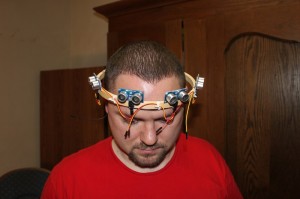HALO – Haptic Feedback System for Blind/Visually Impaired
by Steve Struebing on Dec.12, 2010, under technoPHILE
Complete Build Instructions:
Please visit www.instructables.com for the complete build instructions and story.
httpv://www.youtube.com/watch?v=hfXs5rhwCfE
Highlights/Features
– Approximate 4 feet of range
– Variable haptic sensation (frequency and intensity of vibrations increase as range decreases)
– Just over 180 degree field of view from 5 Parallax Ping))) Ultrasonic Rangefinders
Background
I have recently been introduced to some new and interesting people with passions for ideas and a belief that our power to be creative with technologies can really make a difference in the world. I used this as a springboard to create the H.A.L.O. This stands for Haptic (meaning touch) Assisted Location of Obstacles. I had watched an episode of “Superhumans” which featured a blind man who used a series of clicks, like a bat, to echo locate his surroundings. I got to thinking about other blind people and their ability to navigate freely – perhaps without the use of a guide dog or cane.
The solution uses a series of rangefinders that take input from sensors and output feedback to pulse vibration motors placed on a person’s head. As a person gets closer to an object the intensity and frequency of the vibration increases – it’s directly proportional to the distance of an object. If a region was lacking feedback, then it is safe to proceed in that direction.
Perhaps this can be useful for the visually impaired to have the freedom to possibly move about hands-free without the assistance of a cane or seeing eye dog, or serve as a complementary enhancement to those solutions. Technology has undoubtedly made our daily lives better. By using a few inexpensive components and sensors, I’ve made a device that will allow the blind to navigate their surroundings and avoid collisions.
Great posts and comments over at:
http://hackaday.com/2010/12/17/haptic-feedback-for-the-blind/#comments
http://walyou.com/haptic-assistance-for-the-blind/
http://blog.makezine.com/archive/2010/12/project_halo_helps_you_navigate_wit.html
Photos








December 13th, 2010 on 10:17 am
[…] when you use the on-screen keyboard, but there’s plenty more potential for the technology. Steve Struebing has come up with HALO – Haptic Assisted Location of Obstacles – a headband intended to allow […]
August 21st, 2011 on 10:18 pm
Hi Steve,
Congratulations on this wonderful creation.
I am Tulane eye doctor taking care of lot of visually handicapped /blind people. I have been dreaming of something like the HALO. My patients would benefit from this. How can i get my hands on this device to see if this can help my patients?
Also, i have several other ideas that can improve the device. That is if you are open to suggestions. Let me know.
Best
RA
Professor,
Ophthalmology,
Tulane School of Medicine
September 2nd, 2011 on 3:41 am
Interesting… I have also used sparkfun extensively to design my “haptic radar” headband:
http://www.k2.t.u-tokyo.ac.jp/perception/HapticRadar/index-e.html
as well as the “haptikar”:
http://www.k2.t.u-tokyo.ac.jp/perception/haptiKar/index-e.html
and haptic “mask” (haptikat):
http://www.k2.t.u-tokyo.ac.jp/members/alvaro/HaptiKat/haptikatmask.wmv
September 2nd, 2011 on 8:23 am
Excellent! I saw your work after I had made my version. Perhaps we can exchange notes to see how your device did and what some of the issues were. You’ve made some great projects!
Steve
September 2nd, 2011 on 10:01 am
I would love to exchange notes in order to make this idea advance! There is a lot of info I still have to publish, but there is already some ideas in the papers. The thing I am burning to make public is a test we did in Brasil two years ago, with 50 real blind people in collaboration with a French researcher (she worked with Bach-y-Rita, a pioneer in the field). One thing I can tell you is that every single one of the tests subjects were enthralled, and all convinced this would be very helpful for them… I am right now sending a new version of the system (wireless, with data log on a computer) to a physiologist in Austria. Anyway, yes! would be happy to check data, and perhaps put all our energies in synch to help the blind. By the way, do you have a website?
Keep up the good work, and thanks for the answer
Cheers,
Alvaro
September 2nd, 2011 on 10:13 am
…if I had to say now, I think the main issue I had is that the vibrators are linked (mechanically speaking), so the vibration is not extremely localized. This may not be a problem for a few sensors/vibrators, but it may pose a problem for larger number of sensors – I’ve been using from six to eight sensors/vibrators. Also, it is clear that motor vibrators are not the best thing as a “tactor”, but the cheaper solution of course
September 2nd, 2011 on 10:20 am
and another thing I noticed in your video: you don’t move your head much; you will notice if you use the device longer, that you will naturally start “scanning” the space as a dolphin with its sonar does; I have some videos in which a japanese actor (the device was on tv here) start naturally moving in a very funny way, like a dolphin exploring the surrounding. It was very natural. I had the same feeling when using a single module, you can see some video here: http://www.youtube.com/alvartube?gl=JP&hl=ja#p/u/54/db87A9KydZ8
January 30th, 2012 on 11:14 pm
Hi, Thank you for all the wonderful work. I am blind and I will be happy to assist with some ideas for your project. I am convince that is verry possible to build an efective navegation sistem for the blind. God bless you all. Aggi C.